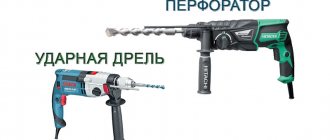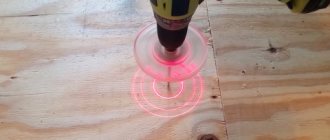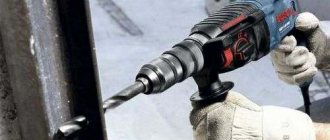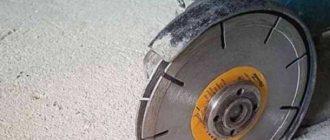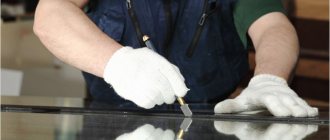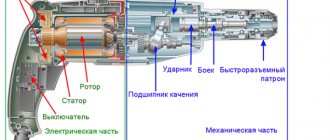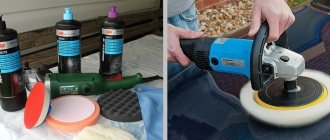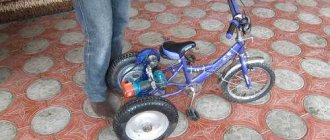Preparation of cement mortar is an integral part in construction work. Mixing it in large quantities is quite difficult and also requires a lot of time and effort. A hammer drill or a powerful electric drill is well suited for this. You should not rush to rent, much less buy, a concrete mixer or construction mixer. In most cases this is completely unnecessary.
Is kneading allowed with any instrument?
It is important to understand that the weaker the power tool, the harder it will work. If we are talking about using a drill, then it should be borne in mind that not every model is designed for this kind of load. For example, a 500 W device is not capable of fully mixing the building mixture. If you work intensively, the drill motor will definitely fail. With such a tool you can stir the solution only in very small volumes (about 10 l) and for a short time. It is also important that it is not thick concrete, but putty, primer, or similar mixtures.
It’s a completely different matter; this is an electric drill with a powerful 1300 W motor, preferably 1500 W. Such a model can quite cope with mixing mortar. However, you should still not overload the tool with increased work intensity, or try to knead too thick a mass.
As for using a puncher for kneading, this is a more reasonable solution. This tool is designed for increased loads and is equipped with a powerful power unit. However, it is best to take frequent breaks when mixing concrete.
Where else can we use a hammer drill?
The scope of implementation of the hammer drill is not limited to working with concrete or stone. Wherever striking equipment is required, this universal device can be used.
Do-it-yourself drill sharpening
When using a carbide-tipped drill (drill), it wears out from impacts and friction. With all this, the soldering does not have time to develop its own resource before the drill breaks down. This is especially noticeable on an instrument of huge diameter. This leads to decreased productivity and unnecessary costs for consumables. Therefore, it makes sense to sharpen drills without the help of others. To do this, you need to use a sharpening machine (emery).
READ How to Remove the Cover from a Grinder
When sharpening a drill yourself, it is important to maintain the unique angles made at the factory. Their values are: 30 degrees - the front edge, 60 degrees - the back. For greater sharpening accuracy, a device is made from an angle, which fixes the drill in a suitable position when sharpening it.
How to mix the solution?
Regardless of the choice of tool, the construction mixture should be mixed from as liquid a consistency as possible to a thicker one. In other words, you need to add cement and sand to one bag in two, or better yet, three batches to achieve the required density. If you try to immediately make a very dense solution, it will be quite difficult and will negatively affect the engine and the internal mechanism of the power tool.
It is also important to choose the right nozzle. In the assortment of construction stores you can find three types:
- screw;
- cruciform;
- combined.
Screw mixers are used to obtain liquid mixtures, and cross mixers are used for thicker ones. Cross-shaped nozzles with a right-handed spiral work well with a solution containing gravel or crushed stone. The nozzle evenly distributes the components throughout the entire volume, preventing them from falling to the bottom. Combined nozzles are a universal solution and can be used in mixing any building mixture.
To minimize the load on the drill, it is better to give preference to a mixer with the smallest possible working part. The wider the mixer blades, the more power is required to rotate them under the load of the solution. You can purchase a more impressive mixer for a hammer drill than for a drill. Because this tool can work under heavy load and develops more power.
Types of nozzle shanks
Depending on the shape of the shank, the attachment can only be used with a mixer or with a drill and hammer drill. Here are a few types of shanks found in mortar mixing attachments:
- Hexagon . This is the most common type of shank and is easily clamped by the drill chuck. These attachments can also be used with construction mixers. They have the following standard sizes: 8, 8.5, 9 and 10 mm. For example, one of the popular ones is the KWB 4977-08 with a shank diameter of 8.5 mm.
- Hexagon with groove for spring fastening . This shank is designed for HEX or keyless chucks. These attachments are most convenient for mixing mixtures with a screwdriver, although they are also suitable for a drill. However, you need to take a powerful device with high torque.
- Threaded . Here at the end there is a thread with a tightening nut. The most popular sizes are M12 and M14. They are used exclusively in conjunction with construction mixers. This is the most reliable fastening that can withstand high loads and high torque, therefore large beaters for mixing heavy mixtures are usually produced with such shanks.
- Shank for SDS+ chuck . This is also one of the types of hexagons, but with grooves for attaching to an SDS+ cartridge. We can say that these attachments were produced specifically for rotary hammers, so if you are the happy owner of such heavy equipment, be guided by the appropriate attachments.
There are also nozzles with Morse taper shanks, but they are intended for industrial use and are not practical to use at home.
How to correctly insert and remove a drill bit into a hammer drill, screwdriver and drill
The popularity of the question of how to insert a drill into a hammer drill or electric drill can be explained quite simply: such devices are actively used both in industrial and domestic settings.
The cartridges are different, as are the attachments attached to them.
How to attach a drill bit to a hammer drill? change cartridge
An incorrectly installed drill can lead to a number of problematic situations:
- inability to work with a hammer drill or drill;
- obtaining uneven holes with a broken inner surface;
- the drill may fly out, which can result in serious injury.
Despite the fact that inserting a drill bit into a rotary hammer or drill is not so difficult, this issue should be approached responsibly.
The process of preparing concrete manually
How to prepare concrete with your own hands so that the mixture turns out to be of high quality? This question interests many builders, because you can mix concrete, but who will then be responsible for cracks and uneven coverage? Today there are two ways to prepare concrete using a mixer. To prepare a small amount of concrete in the shortest possible time and get excellent results, you can use either one or the other - your choice.
1. The first method is the most common. First, the dry ingredients are mixed in the required proportions. Cement is carefully and evenly mixed with sand in proportions of 1 to 3. Gravel is added. Stir for 5 minutes. Only then, in the evenly stirred mixture, make a funnel (you can use a shovel). A measured amount of water is added to it. And they interfere again. This manipulation (water at the end) is carried out so that water cannot lift light cement to its surface, preventing uniform mixing. If you pour water over the cement itself, it will lead to lumps in the mixture, and who needs them? In terms of proportions, the optimal option for a mixer is:
- 3 kilograms of cement
- 9 kilograms of sand
- 12 kilograms of crushed stone
- 3 liters of water
The total approximate amount of the mixture is 27 liters. Very suitable for a normal construction mixer.
2. Method two. It consists of pouring water first. And then, cement, sand and crushed stone are poured into a measured amount of water, according to the proportion of concrete preparation. Then, using a drill, this mixture is brought to a uniform consistency. I prefer the first method, because the second can lead to lumps. But, in principle, with a good mixer and the right attachment, the mixture should be homogeneous. The advantage of this method is that less solution sticks to the walls of the container.
How to combine a regular drill with a hammer drill
The hammer drill is used both by professional builders and for home work. But even the best tool will not be able to cope with its task if the drill bit for the hammer drill is chosen incorrectly - without taking into account the surface material and its hardness. Most models are used to perform certain functions, but if you change the equipment, the hammer drill can easily serve as both a drill and a screwdriver. To replace attachments, a special cartridge is used - an adapter, which allows you to quickly change the functions of the device.
conclusions
Concrete is widely used in construction and renovation work. It is necessary for creating foundations, frames, and also when connecting structures. Complex concretes for creating large monolithic structures, as well as mortars for large-scale construction projects, are mixed using special equipment. For a small home line or renovation, it is most convenient to use a construction mixer with a screw attachment. It will mix 20-30 liters of mixture evenly and quickly.
Preparing a concrete mixture is quite simple. Need to:
- Have everything you need on hand (container, mixer, cement, sand, crushed stone and water);
- Prepare additional tools - a wheelbarrow, a shovel and a bucket;
- Know the proportions;
- Follow the methods I indicated step by step.
I hope that now that you have learned how to make concrete, each of you will be able to prepare the required amount and confidently carry out repairs and minor construction work.
How to insert a drill?
A seemingly simple question, which, however, may present some difficulties for inexperienced users holding a hammer drill in their hands for the first time.
- One of them is simple - you need to immerse the drill shank into the chuck until it clicks. After this it will not fall out.
- The second method requires pulling back the chuck skirt before installation. That is, pull it towards the tool body and, holding it in this position, stick the shank into the seat.
The first method is usually used on all professional devices - Makita, Bosch, DeWALT, Hitachi, Metabo, AEG, etc., as well as on branded household models - Skil, Ryobi, Black-and-Decker, etc.
The second is on cheap Chinese units. These are, for example, Caliber, Zubr, Patriot, Kolner, Omax, Whirlwind and a bunch of others. True, it is worth saying that among them there are also models where installation is also carried out using the more convenient first method.
In this case, extraction in both cases is carried out by pulling the skirt towards the body.
What is a hammer drill, how does it work and what is it used for?
A hammer drill is a tool designed for processing the surfaces of building structures and parts of buildings, drilling holes of various diameters in walls and slabs. Differences in the designs of rotary hammers are justified by the variety of models, their modifications and technical additions. The basic mechanism of operation of the device and the scheme of its implementation are preserved in all models.
How to insert a drill into a hammer drill: step-by-step instructions
If, when working with a hammer drill, you take into account all the rules and pay attention to the subtleties, the work will be done well and simply. Always follow construction technologies and do not forget to inspect the tool from time to time for malfunctions.
Functionality check
Before you start replacing the drill or working with the equipment, you need to make sure that it is working. To do this, plug the plug into the socket, and the hammer drill
put it in drilling mode without fighting (last left position). Then the start button is pressed. If you hear an even sound, devoid of glitches and jerks, you can start working.
Before work, do not forget to check the walls or other surfaces for water supply or wiring. The handle must be firmly fixed and not loose during operation. A proper check or inspection will help avoid injuries and damage to the device.
Pay attention: never touch the rotating parts of the tool, otherwise this may lead to a sad ending. For the same reason, you need to install a drill chuck and a drill bit for a bosh hammer drill only with the plug unplugged.
What is a hammer drill
Before installing a drill in a hammer drill, you should first understand. Today it is difficult to complete repairs or construction without resorting to the help of a hammer drill. When drilling is needed, this tool is simply irreplaceable. A hammer drill is used when working with concrete and brick; it is also often used for working on metal or wood as an ordinary drill.
Many features make this tool versatile. rotation with impact, impact without rotation, rotation without impact, drilling in concrete, jackhammer function, drilling in wood and metal and a huge number of others. You should know that there are a huge number of types of hammer drills. The principle of using the tool is similar, but if you need to drill a large and deep hole, it is better to use a larger and more massive device.
How to remove a drill from a hammer drill
If an old drill is inserted into the hammer drill, it needs to be carefully changed. Before pulling out any attachment, be sure to pay attention to the type of its cartridge. Remember about the quick-release chuck and the main chuck. The main one is more reliable, especially when working in shock mode. This cartridge is made of metal, therefore it is least susceptible to mechanical damage.
Before removing the drill from a hammer drill with a double-clutch keyless chuck, be sure to switch the device to reverse mode. Then you need to fix the lower coupling with one hand and the other. unscrew the top one. In a single-sleeve chuck, the nozzle can be changed using only one hand, since it is installed on rotary hammers with automatic shaft locking.
Drill insert
After the above steps, you can insert the Makita hammer drill bit into the chuck. Then, by rotating the upper part of the chuck all the way clockwise, you need to clamp the drill. Then be sure to check whether it is firmly fixed.
If you realize the drill bit is loose, try tightening the chuck more. After final fastening and compliance with all actions, you can turn on the hammer drill
to the network. Press the start button a couple of times so that the lubricant can disperse well throughout the parts.
READ How to Insert a Spring into a Chainsaw Starter
If the drill gets stuck
There are times when the working tool gets stuck in the chuck and does not want to be pulled out. Here you need to know the following. To carefully remove the nozzle, you need to clamp its free part in a vice and hit the chuck jaws with a hammer through a wood attachment until the drill tail comes out of the quick-release chuck. If the drill is firmly stuck in the hammer drill and this does not help, you can remove the chuck and place it in gasoline, and drop a little auto oil into the main chuck.
There are also often situations when the drill gets stuck in the wall during concrete work. This occurs during clamping between concrete and reinforcement. You need to finish pulling the trigger and loosening the hammer drill
, as it may break. First, remove the drill from the chuck, change it and begin to carefully knock out the concrete around the stuck drill. Be careful not to hit a stuck drill bit. After this procedure, the stuck drill can be removed without effort.
Beginning of work
Before you start working, you need to make sure what mode the tool is in. It should be idling for one minute. Be sure to check the operation of the gearbox so that there are no vibrations, excessive noise or sounds coming from it. There should also be no smoke or smell reminiscent of burning insulation.
To drill, you need to place the drill in the place where the hole will be made and only then press the power button. When working with a hammer drill, do not put too much pressure on the surface. Modern rotary hammers have an on/off feature. This property of the tool can provide the main work with a decrease in speed. Thanks to this mode, the hole will be made in a precisely defined place and the drill will not go to the side.
When drilling metal or wood, you should not turn on the impact mechanism mode, this can lead to damage to the device. There are hammer drills that have an automatic shutdown mechanism when the wrong function is selected. During construction work, you can use the impact mode for drilling concrete. To free the hole from dust, you need to remove part of the drill from time to time and return it to its place.
How to use a hammer drill correctly and safely
Hammer
was invented in 1851 as a tool for the mining industry.
In 1932, Bosch presented in Germany the first electromechanical hammer drill designed for construction work.
Since that time, Bosch Hummers have been mass-produced, and other companies have acquired licenses to create them. The main functions of a rotary hammer: drilling, drilling and impact. How to use a hammer drill correctly when performing different types of work? READ Respirator for working with an angle grinder
Some tips for using drilling tools
To avoid the risk of flying tools or concrete chips harming your health, drilling work must be carried out in compliance with all safety measures. Safety precautions include safety glasses, gloves, earplugs or hearing protection. Naturally, all work must be performed in special clothing, in which there should be no hanging elements that could wrap around the drill.
To prevent overheating of the electric tool used for drilling, it is necessary to regularly rest it. It is very important to insert the drill correctly (this must be done until the tool stops).
Two ways to clamp a thin drill in a chuck if the jaws do not reach the shank a little
If the drill gets stuck in the wall during drilling, it should be removed without removing the tool from its surface. To do this, you need to remove the drill from the hammer drill and insert another one, with the help of which you need to begin to destroy the wall around the drill stuck in it.
If the drill cannot be removed from the drill or hammer drill, then it must be clamped in a vice, and then using a hammer, using a wooden spacer, knock on the cams of the clamping mechanism. Oil can help in this matter, a few drops of which are poured into a key type cartridge.
Basic tools for mixing concrete by hand
Mixing concrete, like every work process, begins with the preparation of materials - water, cement, sand. You also need a container - a large vessel - to mix it all.
Let us consider in detail the most important elements in preparing manual kneading of material:
1. Capacity
If you can mix manually with a shovel directly on the ground or on a metal sheet, then you need a bowl for the mixer. The container for mixing concrete should have a trough shape. The most convenient is a metal bathtub or basin. You can also do it in a barrel if it is shallow. The dimensions of the trough depend directly on your need for the finished product. For small amounts of concrete, it is better to take small containers. If it is necessary to lift the finished solution to a height, use containers with special hooks to secure the rope. To extend the service life of such vessels, you should follow a few simple rules. The first of these, which is mandatory, is to constantly clean the inner surface of concrete residues after each use.
2. Construction mixer
Preparation of concrete in small quantities involves the use of a construction mixer. Only this unit allows you to create a uniform mixture, which can then be easily distributed over the work surface. A mixer is the key to high-quality concrete pouring. To mix concrete, you should choose a powerful device that can withstand the full force of the workload. The quality of the nozzle, its material and shape also play an important role. You choose it yourself, since there are cases when the whisk is included. For concrete, screw nozzles are most often used, which prevent air from entering the mixture. A hand-held construction mixer will quickly and easily handle a uniform mixture.
Tools
Now a hammer drill
is one of the more popular tools, so it is difficult to underestimate its benefits.
The tool is used by both experienced professionals and ordinary amateurs. In almost all situations, without this device it would be difficult. In this article we look at how to insert a drill into a hammer drill so as not to destroy it. The masterful ability to use equipment well will help bring your work to perfection. To insert a drill into a tool, you will need a hammer drill , drill bit, chuck and lubricant.
Chuck insert
For proper operation of the tool, you need to lubricate the hammer drill with a special lubricant. It is better to purchase a branded product that is water resistant and prevents water from reaching the iron surfaces, which prevents the appearance of corrosion.
To do this, you need to open the tube of lubricant and squeeze a little into the hole into which the nozzles are inserted. Next, the tool is placed on the floor or on another hard, comfortable surface with the handle, after which the back of the hammer head is pulled down, the chuck is inserted, and the lower part of the head is returned to its previous position.
How to mix the solution with a perforator longer
Once a device is selected, a problem may arise due to premature shutdowns. The reason is simple:
- electric motors of rotary hammers operate with air cooling;
- the fan rotation speed coincides with the speed of the shaft;
- if a viscous liquid is mixed, the speed is low and the force is significant;
- because the motor overheats quickly.
The electronics do not allow the hammer to be restarted until it has completely cooled down. Attempts to remove the sensor from the system, bypass it, or disable it will only lead to premature failure of the device. The radical solution to the problem is the use of external coolers. But still, if the volume of work is very large and it has to be done frequently, it is better to buy an autonomous construction mixer. Of course, we are not talking about renovating one room, but about ongoing large-scale work.
